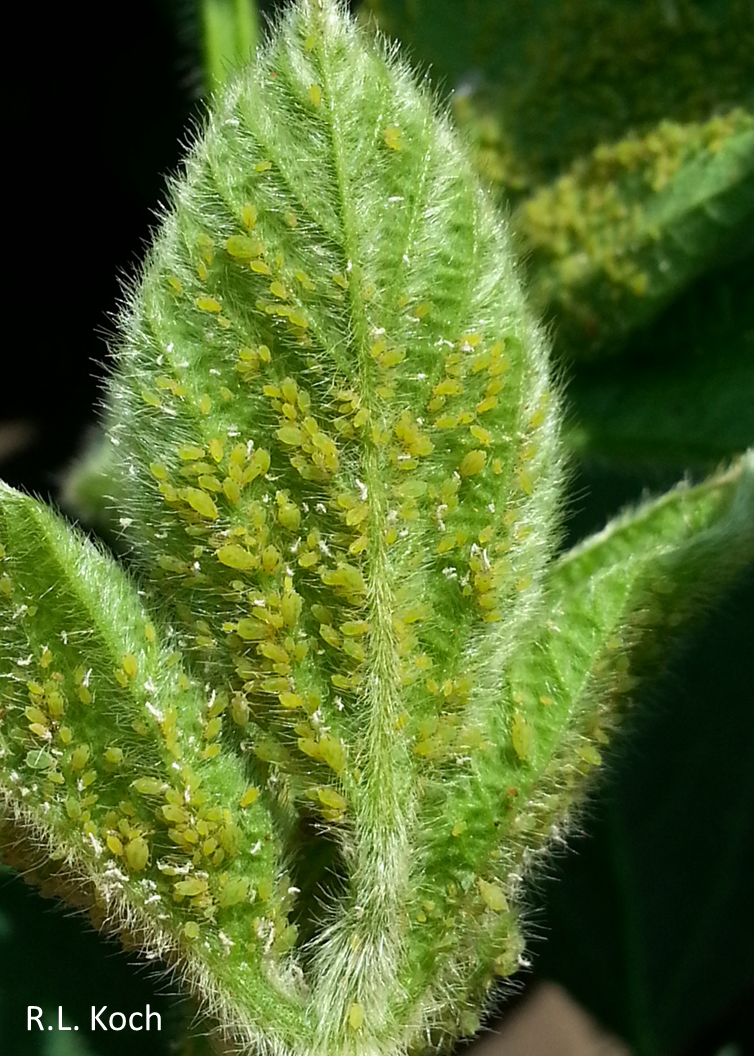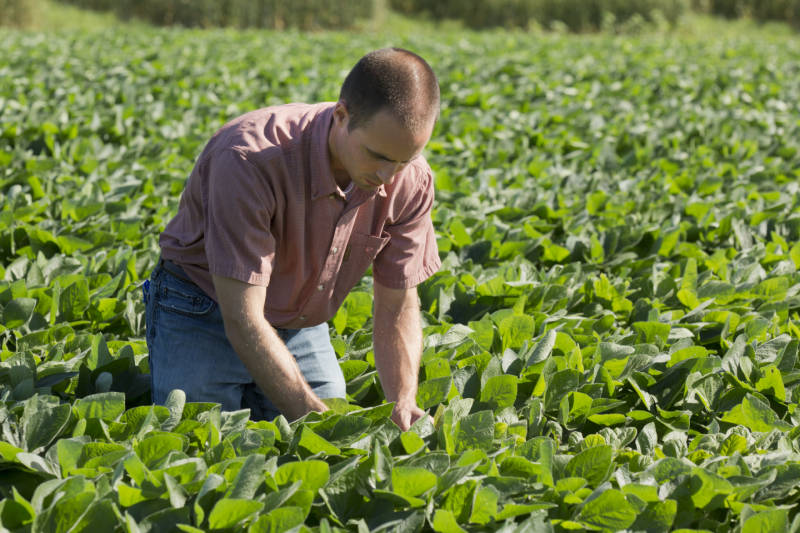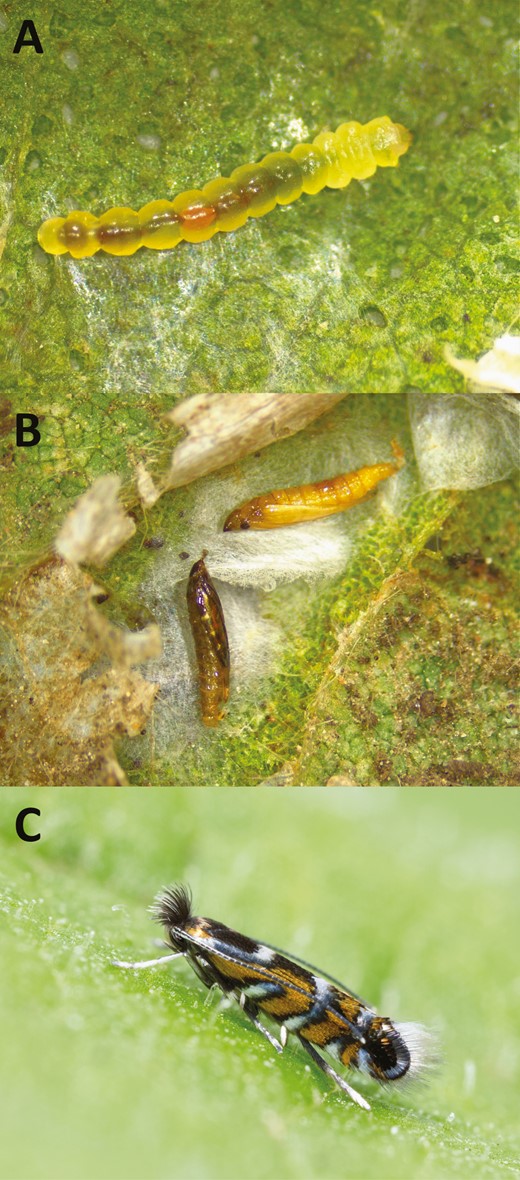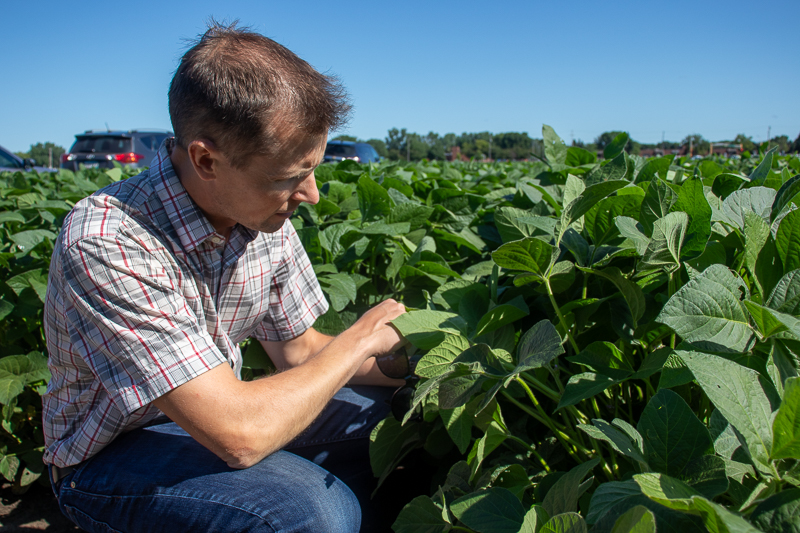by Carolyn Bernhardt
October 16, 2023
In the heart of Minnesota's countless soybean fields, the soybean aphid (Aphis glycines) has long hacked away at production, posing a threat to the region’s soybean industry. “Soybean aphid is an invasive pest whose populations can grow rapidly,” says Robert Koch, PhD, professor and Extension specialist in the Department of Entomology in the College of Food, Agricultural and Natural Resource Sciences. “They feed by sucking sap from the plants.”

Image credit: Robert Koch
Koch says that while soybean aphid infestations have waned in states to the east and south, Minnesota—alongside regions in northern Iowa and the eastern Dakotas—continues to bear the brunt of soybean aphid risk and challenges. For more than 20 years, this insect has prompted farmers to use expensive and harmful insect-killing chemicals. “[This] has resulted in the development of soybean aphid resistance to some insecticides and concerns about environmental impacts of insecticide applications for soybean aphid.”
That is, until now.
Koch has led a groundbreaking research initiative with other scientists to decrease environmental impacts of soybean aphid management using funding from the Minnesota Invasive Terrestrial Plants and Pests Center (MITPPC). The research has empowered Minnesota's farmers by developing aphid-resistant soybean plants and deploying drone technology for targeted, remote surveillance using drones. Koch strives to reduce chemical dependency, save resources, and mitigate the environmental impact of aphid management. The research has already yielded results in preventing outbreaks and curtailing unnecessary insecticide use.

Image credit: David Hansen, umedia.lib.umn.edu/item/p16022coll169:21242
As an unexpected discovery, the project also unveiled a new soybean pest, the soybean tentiform leafminer (Macrosaccus morrisella), adding a new dimension to the ongoing battle for sustainable soybean cultivation.
“The overall goal was a two-pronged attack on soybean aphids,” Koch says. “First, we aimed to improve our ability to respond to outbreaks as they happen by improving scouting and decision-making through remote sensing. Second, we aimed to provide a tool via the aphid-resistant soybean to help prevent such outbreaks from occurring in the first place.”
Aphids can run, but they can’t hide
This team’s research has elevated the use of remote sensing, particularly using drones, to detect soybean aphid infestations. “Ultimately, we hope that we can use remote sensing to identify specific areas of the field with infestation so that entire fields don’t need to be treated,” Koch explains. The researchers successfully crafted a model using real satellite data to precisely assess the severity of aphid infestations in soybean fields. This milestone can help producers and researchers make informed decisions about where and how to apply insecticides to safeguard crop yields.
“The remote sensing we are doing relies on special cameras that can measure how much of the sun’s energy is being reflected from plants,” Koch says. “These patterns of reflection differ between healthy plants (plants with no aphids) and unhealthy plants (plants with aphids), so we can use information from these sensors to assess the level of infestation in a field.”
In other words, they are using these sensors to measure the amount of stress caused to the plants by the aphids, not using the sensors to directly count individual aphids on plants.
The researchers began the process with handheld sensors, then moved to sensors on drones, and just wrapped up a project working with sensors on satellites. The most recent study demonstrates the successful use of freely available satellite data to differentiate between soybean fields with varying levels of aphid infestation. The method helps to make decisions about insecticide application for yield protection.
“Honestly, going into the project, I was cautiously optimistic—actually, maybe even a little skeptical—about our ability to detect and classify aphid infestations based on satellite data, so I was really surprised/impressed with the exciting results we attained,” says Koch. “Our hope is that remote sensing will be used to more efficiently identify fields with concerning levels of aphid infestation that may require further scouting or application of insecticide. And our next big steps are to try to distinguish among different kinds of stress affecting the plants, such as aphids, other kinds of insects, disease, drought, etc.”
A new pest emerges
The remote sensing project also revealed a previously unknown soybean pest, the soybean tentiform leafminer. “We discovered this insect feeding on soybean for the first time in the US in 2021 while sampling our soybean aphid research plots for this project,” Koch says.

Image credits: R. L. Koch for (A) and (B); J. Moisan-De Serres for (C) from J Integr Pest Manag, Volume 12, Issue 1, 2021, 44, https://doi.org/10.1093/jipm/pmab038.
“This is a native species of moth that has historically fed on two species of vining legume plants in forests,” says Koch. “This insect has apparently changed in recent years to now be able to feed on soybean, which is probably good from this insect's perspective because we have millions of acres of soybean [in Minnesota].” Unlike most leafminers, this moth specializes in creating oval-shaped whitish blotches on the undersides of soybean leaves. Its larval mines avoid the central and main side veins.
The team is now working to examine multiple aspects of the biology and management of the soybean tentiform leafminer. They’re looking at its distribution within soybean crops, effects on soybean plants, significance in the agricultural landscape, potential management strategies, and its natural enemies such as tiny parasitic wasps. All of this information is crucial in safeguarding soybean yields from the newfound threat posed by M. morrisella.
Advancing aphid resistance
The team hopes that increasing the availability and the use of aphid-resistant soybeans results in a widely reduced need for insecticides. They have used MITPPC funding to develop several aphid-resistant soybean varieties which significantly enhances the breeding pipeline to include more lines with multiple resistance genes. This would ultimately lead to more effective aphid control.
“Aphid-resistant soybean is a preventative tool for pest management,” Koch says. “If adoption of aphid-resistant soybean were to increase, then the likelihood of farmers needing to spray their fields would decrease. Some aphid-resistant soybean varieties have been released for commercialization and are being used by farmers.”
Although the University of Minnesota Soybean Breeding has made strides, the availability of aphid-resistant soybean lines remains scarce, especially for northern regions. The team recently introduced two cultivars slated for release in the 2024 growing season and there are more varieties in advanced testing stages.

Image credit: Caro Silvola
According to co-investigator Aaron Lorenz, PhD, a professor in the Department of Agronomy and Plant Genetics in the College of Food, Agricultural and Natural Resource Sciences, obtaining genetically engineered herbicide resistance traits is challenging. He says that large seed companies may be hesitant to invest in aphid-resistant varieties due to cost recovery challenges and regional constraints.
University breeding efforts are crucial for establishing a robust base of aphid-resistant soybean germplasm for future development, including potential gene editing techniques to improve efficiency. All this depends on identifying the specific genes responsible for aphid resistance.
Healthy soybeans on the horizon
Now, the scientists are working to secure funding for ongoing research to distinguish soybean stress caused by aphids from other issues and to improve the implementation of the scouting tool. They continue with breeding work using MITPPC funding.
Koch says maintaining close ties with individual farmers, the Minnesota Soybean Growers Association, and agricultural professionals has been essential to this work. “These stakeholders are important in facilitating some of this research by providing letters of support for grant proposals, by allowing us to perform research on their farms, and by being a reality check for some of our ideas.”
Results of this work will be disseminated through Extension programming, which includes online and in-person presentations. “We’re also planning to develop written and video summaries of the work that will be housed online,” says Koch.
He also says it is likely that some of what the team is learning about the relationship of soybean aphid to soybean crops could transfer to some other crop systems where aphids are important pests, such as small grains or cotton. “Funding from MITPPC has allowed us to significantly advance our efforts to improve remote sensing for soybean aphids and increase the availability of aphid-resistant soybean.”
The Minnesota Invasive Terrestrial Plants and Pests Center research is supported by the Environment and Natural Resources Trust Fund, as recommended by the Legislative and Citizen Commission for Minnesota Resources.
Stay connected by signing up for the MITPPC newsletter or follow us on LinkedIn, X, or Facebook.
You may also like...
Decreasing environmental impacts of soybean aphid management, research project
Developing pest-resistant soybean for sustainable management of soybean aphids and Japanese beetles, research project
Aphid-resistant soybean varieties for Minnesota, UMN Extension
Soybean aphid, UMN Extension